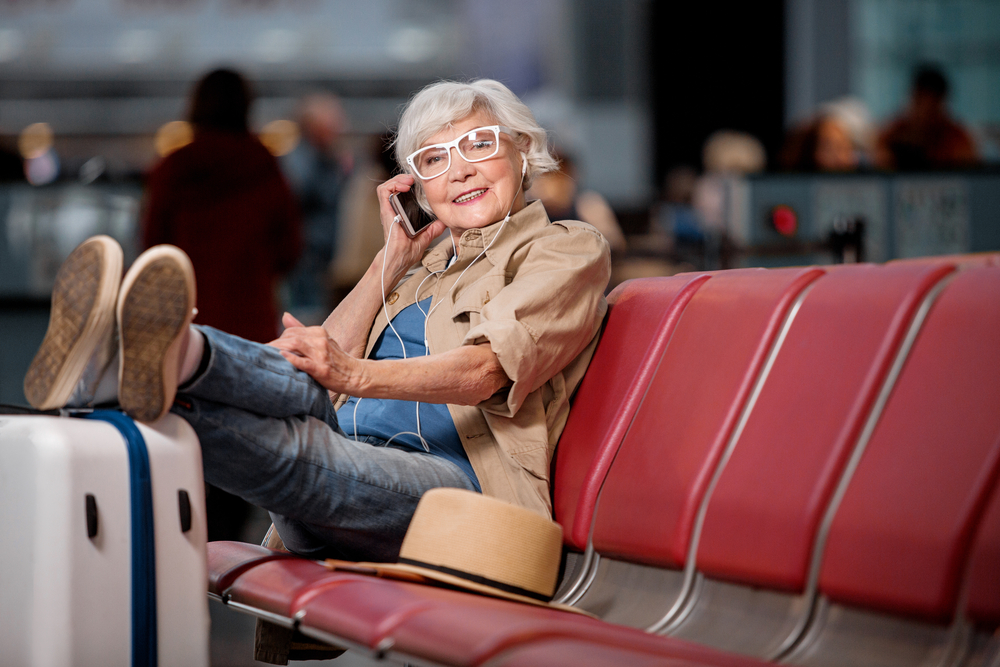Seniors Traveling Alone: Embarking on a solo adventure later in life offers unparalleled freedom and personal growth. However, it also presents unique challenges and considerations. This guide delves into the practicalities, safety aspects, and emotional rewards of solo senior travel, equipping you with the knowledge and confidence to plan an enriching and secure journey.
From meticulous pre-trip planning to navigating potential health concerns and embracing the social aspects of independent travel, we aim to provide a holistic resource for seniors eager to explore the world on their own terms. We’ll cover essential safety tips, practical advice on accommodation and transportation, and strategies for staying connected and engaged while traveling solo.
Safety and Security Concerns for Solo Senior Travelers
Traveling solo as a senior citizen offers unparalleled freedom and opportunities for personal growth, but it also presents unique safety and security challenges. Understanding these potential risks and implementing proactive measures is crucial for a worry-free and enjoyable trip. This section will address common concerns and provide practical strategies for mitigating them.
Safety Concerns by Travel Type
Solo senior travelers face varying safety concerns depending on their mode of transportation. Careful planning and awareness are essential regardless of the chosen method.
- Air Travel: Concerns include lost luggage, medical emergencies in-flight, and navigating unfamiliar airports. Pre-trip planning should involve confirming flight details, arranging for assistance if needed (e.g., wheelchair assistance), and packing essential medications in carry-on luggage.
- Land Travel: This encompasses driving, using public transportation, and walking. Potential risks include car accidents, theft, scams, and getting lost. Strategies include using reputable transportation services, avoiding walking alone at night, and being aware of one’s surroundings. Consider utilizing GPS tracking devices and sharing your itinerary with someone.
- Sea Travel: On cruises or ferries, potential concerns involve seasickness, falls, and medical emergencies. Packing appropriate motion sickness medication, utilizing handrails, and informing ship staff of any medical conditions are important steps. Also, keep valuables secure and be aware of your surroundings.
Mitigating Safety Concerns: Pre-Trip Planning and On-the-Ground Precautions
Thorough preparation significantly reduces risks. Pre-trip planning should include making copies of important documents (passport, driver’s license, medical insurance card), informing family or friends of your itinerary, and researching your destination for potential safety issues. On-the-ground precautions include staying in well-lit and populated areas, avoiding displaying expensive jewelry or electronics, and being wary of strangers offering unsolicited help. Utilizing reputable tour guides or transportation services can also enhance safety.
Essential Safety Items Checklist
This checklist combines physical items and crucial documents to ensure a safer journey.
- Physical Items: Comfortable walking shoes, a well-stocked first-aid kit (including prescription medications), a personal alarm, a flashlight, a portable charger, a map of your destination, and a travel journal to keep track of your whereabouts.
- Documents: Copies of passport, driver’s license, health insurance card, flight/hotel confirmations, emergency contact information, and any relevant travel visas or permits.
Emergency Contact Information Organization
Efficiently organizing emergency contact information is vital. A simple table can help.
| Item | Contact Person | Phone Number | Email Address |
|---|---|---|---|
| Family Doctor | Dr. Jane Doe | 555-123-4567 | [email protected] |
| Next of Kin | John Smith | 555-987-6543 | [email protected] |
| Emergency Contact (Friend) | Sarah Jones | 555-555-5555 | [email protected] |
| Local Embassy/Consulate | [Country Name] Embassy | [Embassy Phone Number] | [Embassy Email Address] |
Health and Wellness Considerations
Solo travel for seniors presents unique health and wellness challenges. Maintaining good health while navigating unfamiliar environments and managing potential medical emergencies requires careful planning and preparation. This section details strategies to mitigate risks and ensure a safe and enjoyable trip.
Potential Health Challenges and Management Strategies
Several health concerns are amplified when seniors travel alone. These include exacerbations of pre-existing conditions like heart disease, diabetes, or arthritis, the increased risk of falls and injuries due to unfamiliar surroundings, and the potential for heatstroke or dehydration, especially in warmer climates. Effective management involves proactive measures. This includes consulting with your physician well before your trip to discuss any potential health risks and obtain necessary medical clearances and prescriptions. Packing a well-stocked first-aid kit containing any personal medications, along with any necessary medical devices, is crucial. Consider carrying a readily accessible medical information card detailing allergies, medications, and emergency contacts. Furthermore, familiarizing yourself with local healthcare facilities and emergency services in your destination is advisable. Maintaining a regular schedule for medication, exercise, and healthy eating habits will also contribute significantly to your well-being. Finally, choosing accommodations with accessible features and opting for less strenuous activities can significantly reduce the risk of injury.
Travel Insurance Coverage for Medical Emergencies
Comprehensive travel insurance is paramount for solo senior travelers. It provides financial protection against unexpected medical expenses, which can be substantial, especially in foreign countries. Policies typically cover emergency medical evacuation, hospitalization, doctor visits, and prescription medication costs. Choosing a policy with high coverage limits for medical emergencies is highly recommended. Some policies also offer repatriation services, ensuring safe return home in case of a serious illness or injury. It’s crucial to carefully review the policy’s terms and conditions, paying close attention to exclusions and limitations before purchasing. Remember to keep your insurance policy details readily accessible throughout your trip. For example, a policy with a $1 million medical evacuation limit and $500,000 medical expense coverage could prove invaluable in a situation requiring emergency airlift and extensive hospital care.
Sample Itinerary Incorporating Rest Days and Flexibility
A well-structured itinerary is essential, allowing for rest and adaptation. This sample itinerary incorporates rest days and flexibility for unexpected health issues.
| Day | Activity | Notes |
|---|---|---|
| Day 1 | Arrival, check into hotel, light sightseeing | Allow time to adjust to the time zone and environment. |
| Day 2 | Moderate sightseeing, exploring local markets | Pace yourself, avoid overexertion. |
| Day 3 | Rest day | Relax, recharge, address any minor health issues. |
| Day 4 | Museum visit, leisurely lunch | Choose activities that suit your energy levels. |
| Day 5 | Optional activity (depending on health and energy levels) or Rest day | Flexibility is key; adapt the itinerary as needed. |
| Day 6 | Departure preparations | Allow ample time for packing and travel arrangements. |
Essential Medications and Proper Storage
Proper medication management is critical. Before your trip, create a list of all medications, including dosages and frequency of administration. Consult your doctor to ensure you have enough medication for the entire trip, plus a few extra days in case of delays. Pack medications in their original containers with labels clearly visible. Carry a copy of your prescriptions with you, separate from your medication. Store medications in a cool, dry place, away from direct sunlight. If traveling by air, keep medications in your carry-on luggage to avoid loss or damage. For medications requiring refrigeration, inquire about storage options at your accommodation. For example, insulin should be stored appropriately to maintain its efficacy. Always consult your doctor or pharmacist for specific storage guidelines for your particular medications.
Planning and Logistics for Solo Senior Trips
Planning a solo trip as a senior requires careful consideration of various logistical aspects to ensure a safe, comfortable, and enjoyable experience. This section will delve into the practicalities of transportation, accommodation, budgeting, and packing, offering guidance for a smoother travel experience.
Transportation Options for Solo Senior Travelers
Choosing the right mode of transportation significantly impacts the overall ease and comfort of a solo senior trip. Each option presents unique advantages and disadvantages. Air travel offers speed and convenience for long distances but can be physically demanding with potential delays and baggage handling issues. Cruises provide all-inclusive packages and ease of movement between destinations, but may lack flexibility and offer limited independent exploration. Train travel offers scenic views and a relaxed pace, though it can be slower and less direct than air travel. Driving offers the greatest flexibility but requires physical stamina and careful consideration of driving conditions and distances. Finally, bus travel is a budget-friendly option, but may be less comfortable and slower than other modes.
Senior-Friendly Accommodation Options
Selecting appropriate accommodation is crucial for a comfortable and relaxing trip. Senior-friendly options prioritize accessibility and convenience. Hotels with accessible rooms, including features such as roll-in showers, grab bars, and elevators, are ideal. Consider hotels with on-site amenities such as restaurants and transportation services. Retirement communities or resorts often offer specialized packages for seniors, including health and wellness services. Vacation rentals can provide more space and privacy, but may lack the amenities of hotels. When selecting accommodations, ensure easy access to medical services if needed.
Sample Budget for a 7-Day Solo Senior Trip
A realistic budget is essential for planning a successful trip. The following is a sample budget, which can be adjusted based on individual preferences and destinations. These are estimates and actual costs may vary.
- Flights: $500 – $1000 (depending on destination and time of year)
- Accommodation (7 nights): $700 – $1400 (ranging from budget-friendly hotels to more luxurious options)
- Activities and Entrance Fees: $350 – $700 (depending on chosen activities)
- Food and Drinks: $350 – $700 (allowing for a mix of dining in and eating out)
- Transportation (local): $100 – $200 (consider using public transport or ride-sharing services)
- Miscellaneous Expenses: $100 – $200 (souvenirs, unexpected costs)
Total Estimated Cost: $2100 – $4000 (This range accounts for a significant variation in travel style and destination)
Packing List for a 7-Day Solo Trip
Packing light is essential for solo senior travelers. Prioritize comfortable and practical items.
- Lightweight clothing items (mix and match)
- Comfortable walking shoes
- Medications (with copies of prescriptions)
- First-aid kit
- Toiletries (travel-sized)
- Copies of important documents (passport, itinerary, insurance)
- Small backpack or day bag
- Universal adapter (if necessary)
- Reading material
- Camera
Accessible Travel Options for Seniors with Disabilities
Traveling independently can be a fulfilling experience for seniors, but those with disabilities may face additional challenges. Fortunately, many resources and options exist to make travel more accessible and enjoyable. This section explores ways to research and book accessible transportation and accommodations, identifies helpful resources, and details adaptive travel gear and assistive devices.
Researching and Booking Accessible Transportation and Accommodations
Finding accessible travel options requires proactive planning. Begin by identifying your specific needs – wheelchair accessibility, hearing assistance, visual aids, etc. Then, utilize online booking platforms that allow filtering by accessibility features. Websites of airlines, train companies, and hotels often have dedicated sections for accessibility information, detailing features like wheelchair-accessible restrooms, ramps, elevators, and accessible rooms with wider doorways and roll-in showers. When booking, always directly contact the provider to confirm accessibility details and request specific accommodations. Don’t hesitate to ask questions and clarify any uncertainties; a phone call can often resolve potential issues before your trip. For example, confirming the availability of a ramp at a hotel or the presence of audio-visual announcements on a train can significantly enhance your travel experience.
Resources for Seniors with Disabilities Traveling Independently
Several organizations offer support and resources to seniors with disabilities planning independent travel. The National Disability Rights Network (NDRN) provides information and advocacy related to disability rights, including travel accessibility. Many local disability organizations also offer travel assistance programs or can connect you with relevant resources in your area. Consider contacting your physician or therapist; they might be able to provide referrals to specialized travel agencies catering to the needs of people with disabilities. These agencies often possess extensive knowledge of accessible destinations and can handle the logistics of booking accessible transportation and accommodations, significantly easing the planning process.
Adaptive Travel Gear and Usage
Appropriate adaptive travel gear can significantly enhance a senior’s travel experience.
- Lightweight, maneuverable wheelchairs: Choose a wheelchair that is easy to fold and transport, possibly with features like adjustable armrests and footrests for optimal comfort.
- Travel-sized mobility scooters: Compact and lightweight scooters are ideal for navigating airports and other travel environments.
- Adjustable walking canes or crutches: Provide stability and support while traveling, especially when navigating uneven terrain.
- Adaptive clothing: Easy-to-dress clothing with features like magnetic closures or Velcro fastenings can simplify the process of getting ready.
- Medication organizers: Ensure you have a reliable system for carrying and managing your medications during travel.
Comparison of Assistive Devices Suitable for Travel
Choosing the right assistive device depends on individual needs and travel style. Wheelchairs offer greater mobility but can be cumbersome to manage in some settings. Mobility scooters provide more comfort and speed but may be less maneuverable in crowded areas. Walking canes or crutches are lighter and easier to transport but offer less support than a wheelchair or scooter. The best option often involves a combination of devices tailored to specific needs and travel environments. For instance, a senior might use a wheelchair for longer distances and a cane for shorter distances or navigating more compact spaces. A thorough assessment of your mobility needs and the anticipated travel environment is crucial to making an informed decision.
Closing Notes
Ultimately, the experience of seniors traveling alone is deeply personal and rewarding. By carefully considering the practicalities, prioritizing safety, and embracing the social opportunities, seniors can embark on enriching adventures that foster independence, self-discovery, and lasting memories. This guide serves as a starting point; remember to personalize your trip to align with your individual needs and preferences, ensuring a safe and fulfilling experience.




